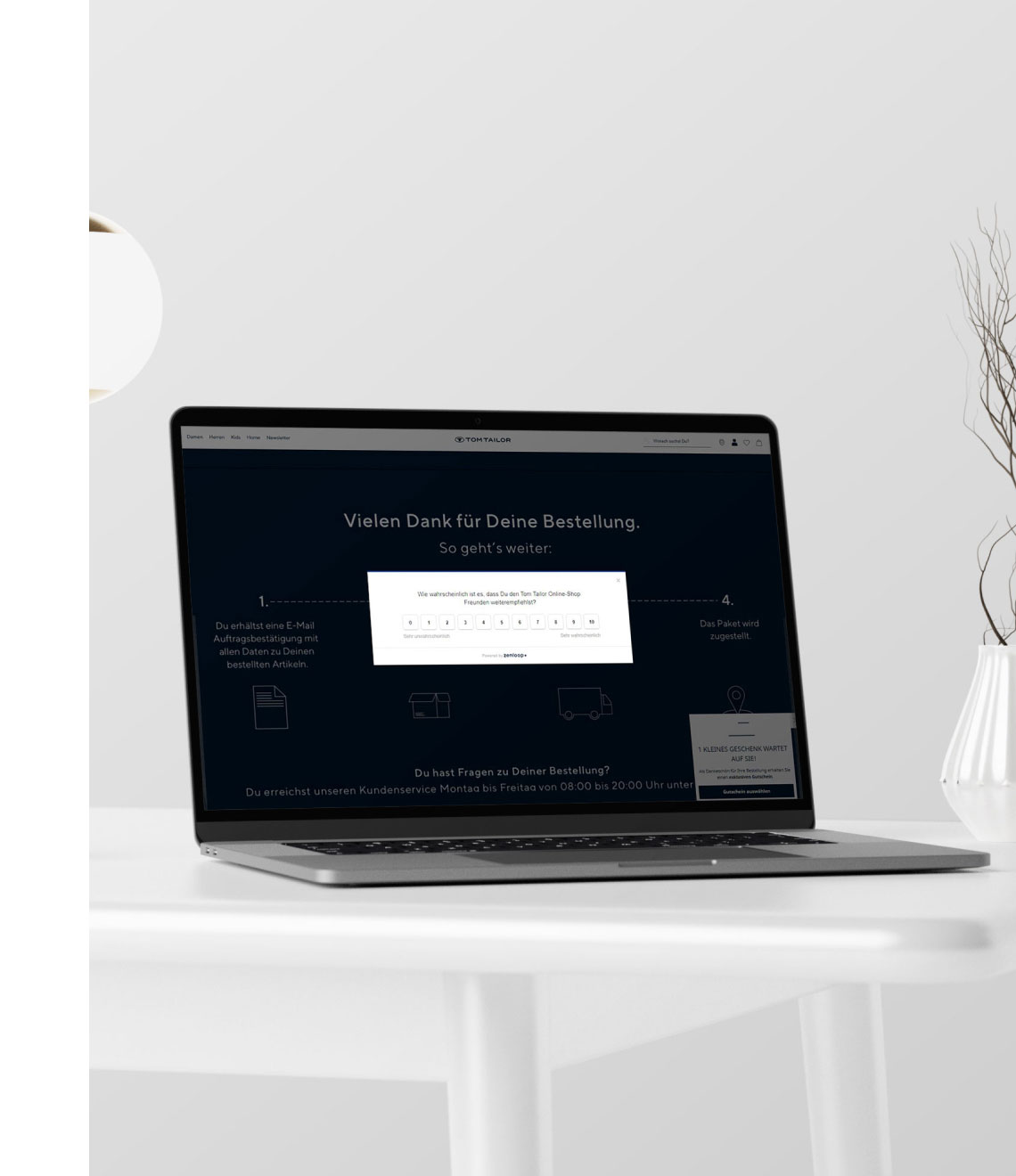Converting Detractors to Promoters Using the Email Journey
Case Study

How Tom Tailor builds holistic feedback loops to increase customer satisfaction

About Tom Tailor
Tom Tailor is a fashion brand that is known worldwide with 450 retail stores, 10,000 diverse retail and online partnering outlets like Galeria and Zalando, as well as the company’s own online store, where they place great emphasis on customer experience.
To increase customer satisfaction and build long-term and sustainable relationships with their customers, Tom Tailor partners with the action-oriented experience management platform zenloop. Since 2019, the company has been gathering customer feedback at four important customer touchpoints – including after-purchase and after-delivery touchpoints – two particularly emotional and decisive moments that customers go through in the purchasing process.
The Challenge
Purchase completion and order delivery are among the most critical moments in the customer journey. Customers are happy that their purchase has been completed and eagerly await their order to be delivered. That’s why delivery time plays such an important role – because the goods received are either satisfactory or unsatisfactory. The packages are then opened, and the clothes tried on. At this moment there is joy, and the customer is happy with the order, or disappointment sets in if the item doesn’t meet customer expectations.
Generally speaking, customer satisfaction is very high once the ordering process has been completed – unless the customer has had to deal with errors and poorly functioning processes. However, at the time of delivery, customer satisfaction can be quite different. Consequently, Tom Tailor has recognized that these two moments are decisive for customer satisfaction and the repurchase rate, not only on their own but also in combination with each other.
Therefore, the company has set itself the goal of taking an even closer look at the reasons for dissatisfaction and a better understanding of when this occurs. On the other hand, satisfied customers should also be cared for, to extend their loyalty to the brand.


The Solution
Tom Tailor uses the Net Promoter Score (NPS) to determine customer satisfaction. To calculate this, customers are asked to indicate on a scale of 0 to 10 how likely they are to recommend the company to others. The higher the number, the greater the likelihood of recommendation and, consequently, the greater the level of satisfaction. Respondents can then add a comment explaining the reasons for their rating.
Based on the score given, customers are divided into three groups:
- Promoters (score of 9 or 10): They are among the fans and supporters of a company and can potentially infect others with their enthusiasm.
- Passives (score of 7 or 8): Their attitude is neutral, and they have neither a very positive nor a very negative opinion of the company.
- Detractors (score from 0 to 6): They are very dissatisfied with the company and therefore belong to the critics. They may also express their displeasure in the form of negative reviews or comments on public platforms.
To establish the connection between the two contact points, Tom Tailor developed an automated email campaign with personalized content based on the last purchase. Within this email campaign, customers are asked about their satisfaction at both touchpoints, and further actions are initiated based on their responses.
Step 1:
After completing their order, customers are asked via website overlay to provide the NPS on their likelihood to recommend the Tom Tailor online store. Here’s an example from the German website:
Step 2:
Based on the rating, various actions are triggered:
- Detractors who submitted a comment are contacted by customer service to resolve the reason for dissatisfaction in a face-to-face exchange.
- All detractors who only left a rating but no comment, as well as passives and promoters, receive triggered messages as part of the email campaign.
Step 3:
The email campaign starts and runs for a period of 20 days and includes three email triggers:
First Email: One day after ordering or submitting their review, respondents receive an email from Tom Tailor thanking them for their positive feedback:
” Thank you so much for your feedback! We were very pleased with your score of X …”
Second Email: 14 days after the order is placed, another survey is sent via zenloop. To get specific product feedback, Tom Tailor asks in this email about satisfaction with the goods received. Respondents can answer either “satisfied” or “dissatisfied.”:
” You recently ordered from us. Your satisfaction is especially important to us. Are you still satisfied with your order?”
Third Email: Depending on the response to email #2, two different emails are sent:
- If the customer is satisfied with the goods received, they will receive another email three days after answering the survey in the previous email. Tom Tailor thanks the customer again for their positive feedback and depending on the situation, may also add vouchers or other goodies, for themselves or to share with friends:
“Glad you are still satisfied. We’ll give you 15% off your next purchase and 15% to share with friends…” - If the customer is not satisfied with the goods received, he or she will receive an apology email the very next day, which will also include a voucher:
“It’s a pity that you are no longer satisfied. We thank you for your honest feedback and hope you will give us another chance. In return, we’ll give you a 15% discount on your next order!”
Depending on the feedback received, customers are also personally contacted by the customer support team to work out a solution.


The Result
The company also creates additional touchpoints that enhance the customer’s buying experience by signaling, among other things, that Tom Tailor cares about customer satisfaction for all of its customers. The second email, inquiring about satisfaction 14 days after receiving the delivery, provides essential insights into both the quality of the merchandise and overall satisfaction. Since customers have most likely had time to wear the item at this point, they can report not only on their experience with the delivery but also on their impression of the products themselves. In order to close the feedback loop back into the company, this feedback is then forwarded to the relevant departments for further processing.
Since the launch of this campaign in April 2021, Tom Tailor has recorded an increase in the Net Promoter Score by six points, at the two touchpoints after-purchase and after-delivery.
Promoters & Passives
In general, Tom Tailor recorded excellent engagement with above-average conversion rates, including incentives to make further purchases, especially with promoters and passives. The emails had an outstanding open rate throughout the campaign and a strongly increased conversion rate – without significant differences between the two customer groups. Promoters and passives show a 66 percent higher conversion rate compared to the average of customers who do not go through the email journey.
Detractors
The email campaign also had a positive effect on detractors. Approximately 11 percent of detractors made a repeat purchase after receiving the emails – an above-average level. In addition to this positive development of the conversion rate, personal communication from the customer service team clearly influenced customer satisfaction. For example, by addressing customers individually, a significant increase in satisfaction was recorded, converting those detractors into promoters.
For the future, Tom Tailor plans to expand the email channel further to continuously improve the customer experience and gain important insights about its products and reasons for (dis)satisfaction. Further projects are also planned as part of the successful collaboration with zenloop.
Learn how zenloop can help your business, too.






